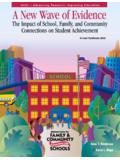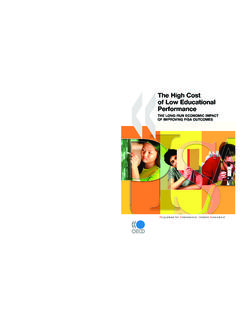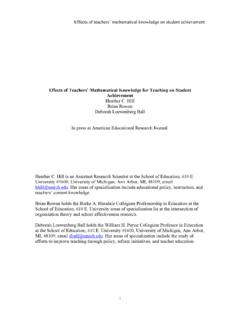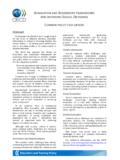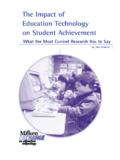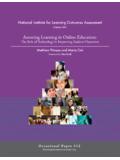Transcription of The Learning Portfolio: Reflective Practice for …
1 The Learning Portfolio: Reflective Practice for improving Student Learning John Zubizarreta Professor of English Director of Honors and Faculty Development Columbia College, SC USA 2 -- --Material adapted from The Learning Portfolio (Anker, 2004) The Learning Portfolio: What Is It? The Learning portfolio is a flexible, evidence-based process that combines reflection and documentation. It engages students in ongoing, Reflective , and collaborative analysis of Learning .
2 It focuses on purposeful, selective outcomes for both improving and assessing Learning . 3 The Learning Portfolio Reflection + Documentation + Mentoring = Learning ! 4 Course assessment/evaluation Major/departmental outcomes General Education program review/assessment Academic advisement Teacher preparation Internship/practicum Service Learning Field/experiential Learning Prior Learning assessment Fine arts Technical/professional skills Career preparation Successful Use of Learning Portfolio Student Learning !
3 5 Levels of Bloom s Taxonomy Difficulty and Complexity Complexity Difficulty Knowledge Comprehension Application Analysis Synthesis Evaluation Complexity and difficulty are different. Complexity establishes the level of thought; difficulty determines the amount of effort within each level. --Adapted from David A. Sousa, How the Brain Learns, 2nd ed. (Corwin, 2001) 6 The Role of Learning Portfolios in Creating Significant Learning Experiences: --From L. Dee Fink (Jossey-Bass, 2003) The Integrative Relationship of Learning Portfolios --Graphic from J.
4 Zubizarreta, Learning Portfolio (Anker, 2004) In Creating Significant Learning Experiences, L. Dee Fink proposes an innovative taxonomy of higher-level Learning as the foundation for an integrated approach to designing college courses and other Learning experiences. Fink s model stresses the importance of active Learning and educative assessment (as opposed to simple auditive assessment ). One powerful tool for meeting the needs of higher-level Learning and bridging the goals of active Learning and educative assessment is the Learning portfolio.
5 Educative Assessment: Basic ComponentsForward-LookingAssessmentCrite ria &StandardsSelf-Assessment FIDeLity FeedbackLEARNING PORTFOLIOS A Model of Active LearningInformation& IdeasExperience 7 WHAT SHOULD A STUDENT INCLUDE IN A Learning PORTFOLIO? There is no single right answer. Contents are determined by the purpose of the portfolio. But here is a very generic table of contents, organized by broad categories and certainly not prescriptive or exhaustive. The table is meant to be suggestive, inviting multi-disciplinary ideas of what the actual, complex contents of a student portfolio might be, remembering the caveat that purpose will drive final decisions about both reflection and documentation.
6 _____ Table of Contents 1. Philosophy of Learning ( Reflective narrative on Learning process). 2. Achievements in Learning (transcripts, course descriptions, r sum s, honors, awards, internships, tutoring). 3. Evidence of Learning (research papers, critical essays, field experience logs, creative displays/performances, data/spreadsheet analyses, course electronic listserv entries). 4. Assessment of Learning (instructor feedback, course test scores, exit/board exams, lab/data reviews, research project results, practicum reports).
7 5. Relevance of Learning (practical applications, leadership, relation of Learning to personal and professional domains, ethical/moral growth, affiliations, hobbies, volunteering, affective value of Learning ). 6. Learning Goals (plans to enhance, connect, and apply Learning ). 7. Appendices (selected documentation). Adapted from The Learning Portfolio: Reflective Practice for improving Student Learning (Anker, 2004) 8 Sample Questions for Student Reflection The durable value of Learning portfolios in improving student Learning resides in engaging students not just in collecting representative samples of their work for assessment, evaluation, or career preparation but in addressing vital Reflective questions that invite systematic inquiry: What have I learned?
8 When have I learned? In what circumstances? Under what conditions? How have I learned or not, and do I know what kind of learner I am? How does what I have learned fit into a comprehensive, continual plan for Learning ? What difference has the Learning made in my intellectual, personal, and ethical development? In what ways is what I have learned valuable to learn at all? Why did I learn? 9 Sample Assignment Sheet for Learning Portfolio (Brookfield 1995) Instructions on Keeping a Learning Journal The purpose of this journal is twofold.
9 First, I hope it will give you some insight into your own emotional and cognitive rhythms as a learner. By this, I mean that you will become more aware of how you go about organizing your Learning , what kinds of Learning tasks you are drawn to, what teaching styles you find most congenial, what tasks you resist and seek to avoid, what conditions encourage you to take risks in Learning .. Second, and more selfishly, I hope that you will be ready to share some sections of your journal with me.. If you d like some structure to help you with the first few weeks entries, try writing a few lines in response to the following questions: What have I learned this week about myself as a learner?
10 What have I learned this week about my emotional responses to Learning ? What were the highest emotional moments in my Learning activities this week? What were the lowest emotional moments in my Learning activities this week? What Learning tasks did I respond to most easily this week? What Learning tasks gave me the greatest difficulties this week? What was the most significant thing that happened to me as a learner this week? What Learning activity or emotional response most took me by surprise this week? Of everything I did this week in my Learning , what would I do differently if I had to do it again?
